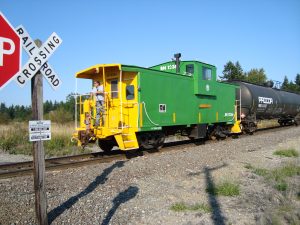by Al Carter, Bob Stafford and John O’Connell
Nineteen hearty souls braved the worst weather of the winter to attend the Clinic. Ted Becker opened the meeting by welcoming our honored guest, Bob Stafford.
Announcements
The idea of having a Saturday clinic in May was suggested and the proposal was well received. This would be a joint operation with our sister clinic in Oak Harbor. Three possible formats were discussed and Multiple Demonstrations won hands down, or I should say hands up. Several people volunteered to do demonstrations. Details to follow, but reserve the day.
Feb 25/26 United Northwest Model RR Club Swap Meet, Monroe. Click here.
Mar 9 Mt Vernon Clinic, Bring a project, materials, and tools and work on it and get your questions answered by the local experts. Well, not experts, but experienced modelers……
Apr 13 Mt Vernon Clinic, Mini-Clinics. Watch this space for details.
May 11 No Thursday evening Clinic!
May 13 Multiple Demonstration, all day event at the Mt Vernon Senior Center. Details coming soon.
Jun 7-10 Pacific Northwest Region Convention, Spokane. Click here for details.
Kit Build
It must have been the weather, but we only had six projects (out of 21) to display.
- Roger Johnson, N scale, completed his building for Mike O’Brien’s layout
- John Biaggio, N scale, completed painting the outside
- Mike O’Brien, N scale, added some weathering and decals
- Ron Nelson, N scale, showed several different weathering methods and mortar application, and added an address number in the window above the door
- Paul Koren, HO scale Walker Building, finished the back as only it will be visible on his layout
- Al Carter, HO scale Walker Building, much weathering and many alterations
With an eye on better weather next month, let’s all bring our projects!
Show and Tell
Ted Becker showed us six HO scale billboards he assembled, 3 of which were Bar Mills and the other 3 were Blair Line kits, all beautifully finished.
Al Carter shared a paper model obtained free from the website www.3dk.ca which features a variety of background buildings in HO and OO scales. The free kit, and the pay-for kits (all very inexpensive) can be instantly downloaded, and printed onto 60# paper, and help fill in the gaps behind buildings on your backdrop. Similar to products from Clever Models, which also has a freebie: www.clevermodels.net
Tool Time
Brian Jacobs shared 3 tools that he finds very useful in general construction (read: building model railroad benchwork):
- An 8 foot saw guide that allows easy ripping of 8’x4’ pieces of plywood with a circular saw
- A (manual, not digital) bevel gauge that allows one to measure precise angles
- A tape measure with a view port on top to see the exact inside measurement
My Workspace
Roger Johnson shared several pictures of his rolling modeling table. Asked what was his favorite feature was, Roger responded he can roll it into the living room and watch UW, Seahawks or Mariner games without missing a beat on his current modeling project. Barbara Johnson quipped that her favorite feature is that it rolls out of sight when they have company. The attached pictures say more than words. Click Roger’s Rolling Model Table to open the PDF.
The Program
Retired BNSF Trainmaster Bob Stafford was our guest speaker and he gave a very interesting presentation of his days working on various railroads, culminating with his stint as Trainmaster in Bellingham, WA from 2007-2010.
Bob’s “authority” in this position covered western Washington from Everett northward. He included diagrams of the yards in Everett (including how the two yards, Bayside and Delta interacted with each other), Burlington, Bellingham, and Sumas.
For each location, he described how “locals” operated out of the yard to serve nearby industries, such as the Conway Turn that runs north from Everett as far as Mount Vernon, serving a few industries along the way in Stanwood, Conway, and interchanging with the Mount Vernon Terminal Railway on Tuesdays and Thursdays.
One of the locals operating out of Bellingham runs trains out to the refineries at Cherry Point, and due to track arrangement, the trains are pushed the seven miles to the customers. So a caboose was placed on the “forward” end of the train to act as the “lead engine”. Bob called in several favors from some of his pals at BNSF and had a caboose “tricked out” to include: a gasoline powered generator, headlight, air horns, vinyl flooring and “special seats” and a lunch table. Definitely not your run of the mill caboose.

Bob’s Caboose “leading” across Valley View with the conductor sounding the air horn for the unprotected crossing
Bob also described how the interchange with the SRY (Southern Railway of British Columbia, nee Canadian Pacific) takes place in Sumas, and related the time that a new USA Customs Agent in Sumas decided to examine the passports of the rail crew members that had crossed into Abbotsford to do the switching and return to Sumas. Things had been pretty lax and the crew did not have their passports, so Bob had to “go to a higher authority” to get the crew back into the country. Needless to say, they all carried passports after that.
Bobs’s anecdotes and presentation were fun to listen to and he makes life on today’s railroads sound interesting. Bob offered the slides he used to anyone interested. Click BNSF Bellingham Sub to view the PDF. Also he offered his email address if you have any questions, spirittowergarden@yahoo.com. Thanks, Bob!


Awsome table, Roger…..